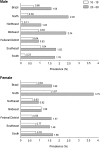Prevalence and risk factors of Hepatitis C virus infection in Brazil, 2005 through 2009: a cross-sectional study
- PMID: 23374914
- PMCID: PMC3574834
- DOI: 10.1186/1471-2334-13-60
Prevalence and risk factors of Hepatitis C virus infection in Brazil, 2005 through 2009: a cross-sectional study
Abstract
Background: Hepatitis C chronic liver disease is a major cause of liver transplant in developed countries. This article reports the first nationwide population-based survey conducted to estimate the seroprevalence of HCV antibodies and associated risk factors in the urban population of Brazil.
Methods: The cross sectional study was conducted in all Brazilian macro-regions from 2005 to 2009, as a stratified multistage cluster sample of 19,503 inhabitants aged between 10 and 69 years, representing individuals living in all 26 State capitals and the Federal District. Hepatitis C antibodies were detected by a third-generation enzyme immunoassay. Seropositive individuals were retested by Polymerase Chain Reaction and genotyped. Adjusted prevalence was estimated by macro-regions. Potential risk factors associated with HCV infection were assessed by calculating the crude and adjusted odds ratios, 95% confidence intervals (95% CI) and p values. Population attributable risk was estimated for multiple factors using a case-control approach.
Results: The overall weighted prevalence of hepatitis C antibodies was 1.38% (95% CI: 1.12%-1.64%). Prevalence of infection increased in older groups but was similar for both sexes. The multivariate model showed the following to be predictors of HCV infection: age, injected drug use (OR = 6.65), sniffed drug use (OR = 2.59), hospitalization (OR = 1.90), groups socially deprived by the lack of sewage disposal (OR = 2.53), and injection with glass syringe (OR = 1.52, with a borderline p value). The genotypes 1 (subtypes 1a, 1b), 2b and 3a were identified. The estimated population attributable risk for the ensemble of risk factors was 40%. Approximately 1.3 million individuals would be expected to be anti-HCV-positive in the country.
Conclusions: The large estimated absolute numbers of infected individuals reveals the burden of the disease in the near future, giving rise to costs for the health care system and society at large. The known risk factors explain less than 50% of the infected cases, limiting the prevention strategies. Our findings regarding risk behaviors associated with HCV infection showed that there is still room for improving strategies for reducing transmission among drug users and nosocomial infection, as well as a need for specific prevention and control strategies targeting individuals living in poverty.
Figures
References
-
- Amon JJ, Garfein RS, Ahdieh-Grant L, Armstrong GL, Ouellet LJ, Latka MH, Vlahov D, Strathdee SA, Hudson SM, Kerndt P. et al.Prevalence of hepatitis C virus infection among injection drug users in the United States, 1994–2004. Clin Infect Dis. 2008;46(12):1852–1858. doi: 10.1086/588297. - DOI - PubMed
-
- Armstrong GL, Wasley A, Simard EP, McQuillan GM, Kuhnert WL, Alter MJ. The prevalence of hepatitis C virus infection in the United States, 1999 through 2002. Ann Intern Med. 2006;144(10):705–714. - PubMed
Publication types
MeSH terms
Substances
LinkOut - more resources
Full Text Sources
Other Literature Sources
Medical


